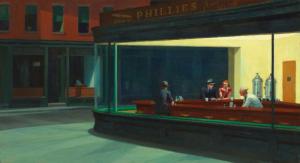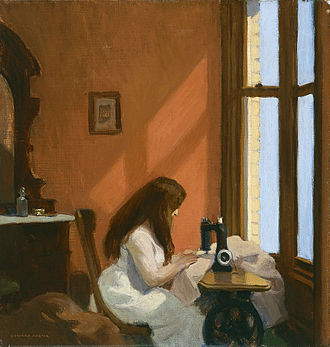 “NIGHTHAWKS” 1942
“NIGHTHAWKS” 1942
Edward Hopper’s paintings seem to be located in a twilight zone born in his own imagination. They depict a world no longer in a state of innocence, but has not yet reached a state of self-destruction.
Hopper shows us a situation that no other American artist captured in quite this way. his spare, personal vision of modern American life became a forerunner of American Pop Art. As a teacher introducing students to Hopper, I found that most were more comfortable painting flowers and sunsets a close second. His use of silent space was sometimes uncomfortable, or perhaps encouraged too much thinking.
He struggled to find his personal style, sometimes going months without finding what he wanted to paint. Working in oil on canvas, watercolor and etchings, he did posters for the War effort, jumping from one medium to another. Often painting over a previous paint while he changed his mind. Once the religious feeling present in the earlier works had dissipated, nothing new replaced it. Only emptiness, a vacuum remained. It wasn’t so much Hopper’s themes that were typically American, as the actual things he depicted; railroads, train stations and gas stations. He was likely the first painter ever to dignify the latter feature of American landscape by using it as a motif in art.
Hopper was a great admirer of Ernest Hemingway. In 1927, Scribner’s Magazine, for whom Hopper did illustrations, published Hemingway’s story The Killers. Hopper wrote a letter to the editors, saying how refreshing it was to find such an honest piece of work in an American magazine, after wading through the endless sugar-coated mush that was usually published. And, he added, the story made no concessions to mass taste.
His ideal was to make his paintings with such simple honesty as to give almost the shock of reality itself.
In 1923 Hopper married Josephine Nivison, an artist who was his exact opposite in every way. She was short, gregarious, sociable, and liberal. He, on the other hand, was tall, secretive, shy, quiet, introspective, introverted and conservative. She once said that “talking to Eddie is like dropping a stone in a well except that it doesn’t thump when it hits bottom.”
 “GIRL AT A SEWING MACHINE” 1921
“GIRL AT A SEWING MACHINE” 1921
He began painting short isolated moments saturated with suggestion. They have silent spaces and uneasy encounters, touching us where we are most vulnerable.
He got more of the quality of America into his paintings of urban landscapes which were filled with poetic meaning.
Typically Hopper, he said “I was never able to paint what I set out to paint.”
research included: (Ivo Kranzfelder)

I’ve always liked Hopper and how he captured slides of American life in a silent, understood way. I used to have a print on my walls. Long since gone. Thanks for the reminder. –Curt
LikeLiked by 1 person
You are very welcome Curt. He has always appealed to my introspective side. I have liked studying the people and wondering what they were thinking. Nighthawks always represented the Great Depression to me; it was part of my childhood in many ways.
LikeLike
I came after the Depression and was raised in a rural setting, but Nighthawks always appealed to me on a visceral level Kayti. –Curt
LikeLiked by 1 person
Really enjoyable portrait of Hopper and a great observation about his use of silent space. From this Australian’s point of view, American society occurs to me as unusually articulate, a society in which verbalising is the way. Silence I imagine would be especially disturbing.
LikeLiked by 1 person
An apt observation on your part Narelle. Dr. A is especially disturbed by too much silence! (grin) Hopper appeals to me on a number of levels. His sense of the bleakness of the Depression comes through in many of his paintings. The dark palette puts the viewer into his mindset, which may be disturbing to many people, but it reaches us in our deepest private selves.
LikeLike
Very well written and informative. I’ve admired Hopper’s work for a long time, but learned a lot from your post. I didn’t know about his marriage or about his self-doubt and difficulties with painting. His paintings do have a chilly feeling to them, but they draw you in.
LikeLike
Hopper is not as well known today, but his quintessential painting :”Nighthawks” still evokes a curiosity to know what those people are doing out late at night and why there in that cafe. He seemed to become more active after his marriage.
LikeLiked by 1 person
Yes, Hopper does ring a bell. I like the introspective quality of his work. Here we had a somewhat similar artist, also somewhat gloomy in expressing his art. He really was an expatriate and lived most of his life in Italy. I can’t say that his work always relates to Australia but for me it sums up some of the aspects of human isolation and vastness of landscape. His name is Jeffrey Smart and here is a link.
http://www.artgallery.nsw.gov.au/collection/works/?artist_id=smart-jeffrey
A good post again, Kayti!
LikeLike
Thanks for the introduction to Jeffrey Smart. He does bear a strong resemblance to Hopper in his approach. I will read up on him.
LikeLike
I loved this post for many reasons, none more than the fact that a very good friend of mine, and artist herself, loves Hopper. Always good to be reminded of the wonderful Sandra Moore. Thanks Kayti, always an education xxx
LikeLiked by 1 person
Thank you for educating me about an artist I’ve long admired, but have known woefully little about. I’ll never again look at one of his paintings without examining his use of silent space.
LikeLike
We could all use more silent space in our lives today. Life would be more peaceful I’m sure. We watched an old movie yesterday in which the action was so fast and noisy I was worn out from the excitement.
LikeLike
Hopper’s one of my favorites, and has been since the first time I found his work. I love places that usually are filled with people when I find them empty — school buildings in summer, hospitals at 3 a.m., all-night coffee shops. He does better than anyone I know at capturing that sense of absence-that’s-a-presence, and as far as i’m concerned, no one captures New York’s feel from previous decades better than Hopper. The painting above is perfect — it’s Chock Full O’Nuts, done by genius.
LikeLike
Great line : “absence that’s a presence”. That is exactly what he brings us. I have vague recollections from the 30’s driving across the country and stopping for a bite to eat or probably coffee to keep my dad awake. The roadhouses looked just like Hopper shows us. Depression and depressing. We were able to make it across country by driving night and day in four days.
LikeLike
I’m an Edward Hopper fan, too. There is a starkness to his art that is singular; they don’t really invite you in — instead you feel like an eavesdropper viewing solitary moments in other people’s lives. One of the projects I had in mind but never got to include in my lesson plans as a teacher (because I got sidetracked into teaching technology) was for students to select a painting and write a story or a poem based on it (a selections of artists). Take “Summer Interior”, or “Automat”; or “New York Movie”; they seem to have story to tell. What has happened to those women? Are they lonely or alone? What happened just before this scene? I think his paintings contain an element of mystery, or unfinished business. Who knows? Too bad artists don’t tell us what they were thinking when they did a particular work of art.
LikeLike
You hit it just right Val. That feeling of mystery and “unfinished business” which infects some of his work is intriguing. the sense of loneliness in some has the same effect. In N>Y Movie, I think the girl is bored because she has probably seen that movie a hundred times and just wants to get home and on with her life. In “Summertime” with the young girl standing on her front steps waiting for someone gives you the same feeling. It’s a mood of anticipation. I like the billowing curtain in the window beside her. Is her mother watching to see if her boyfriend is coming? The new dress shows a new economic prosperity. There is so much humanity to read into his work.
LikeLike